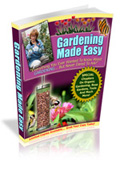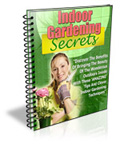Welcome to Gardening Guide
Organic Indoor Gardening Article
 . For a permanent link to this article, or to bookmark it for further reading, click here.
. For a permanent link to this article, or to bookmark it for further reading, click here.
Organic Gardening
from:Organic gardening is a radical development in the world of cultivation and planting. Organic gardening methods try to reduce the usage of pesticides and provide nutrition to the soil through natural means in place of synthetic fertilizers. The key feature in organic gardening is to understand and encourage the ways of nature. By observing the biological conditions, it is evident that nature maintains a very delicate balance. Organic gardening tries to maintain this balance resulting in naturally healthy plants.
The basic chemistry in the growth of the plant is as follows. The roots absorb the water and other minerals and push them to the stems and leaves for photosynthesis. Photosynthesis uses water from the leaves and energy from the sun and converts the carbon dioxide to carbohydrates. These carbohydrates, stored in the branches and stems, provide sustenance for the growth of the plant. They are used to generate new stems and leaves and as a backup in times of crisis e.g. a broken stem or insect attack.
There is a multitude of organic substances resident in the soil. They are various fungi, earthworms and bacteria involved in enriching the soil naturally. They form humus, a soil enriching substance, by breaking down dead leaves and stems. The beneficial organisms found in humus help the plants to absorb more minerals. Some substances are exuded from the roots of the plants that attract beneficial bacterium and other organisms that are helpful in warding off harmful fungi. Another way to make the soil abundant is to add compost to it every year. You can make compost in your backyard with waste materials from the garden and kitchen.
The secret of organic gardening is that harmful insects do not attack healthy plants. They only prey on plants that are intrinsically weak. Therefore, if the plants are made strong internally, there is no fear of a pathogenic attack. No doubt, the common synthetic fertilizers and pesticides destroy the harmful insects. At the same time, they also destroy the beneficial organisms existing in the soil. This throws out the natural balance of the plants. This imbalance makes the plants more prone to another attack.
Over enthusiastic gardeners meddle in the natural pattern of plant growth and greatly harm the plants. The leaves and stems are mercilessly cut down in the name of pruning. This reduces the carbohydrate storages thereby making the plant vulnerable. The plants also become weak and susceptible to an insect attack through hybridization. Enthusiastic weeding is understood to be a sign of a good gardener. How ever, nettles give provisions to ladybirds and thistles support many beneficial insects.
Organic gardening is a haven for the plants and other wildlife too. Grow a range of plants with the help of organic gardening and see the garden bloom.
Organic Indoor Gardening News



